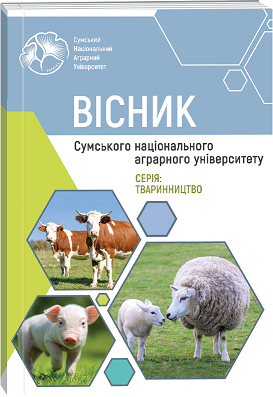ЗМІНИ РАДІОАКТИВНОСТІ МОЛОКА ТА ПРОДУКТИВНОСТІ КОРІВ ПРИ ЗАСТОСУВАННІ У ГОДІВЛІ КОМПЛЕКСОНАТІВ МІКРОЕЛЕМЕНТІВ МІДІ, МАРГАНЦЮ, ЦИНКУ
Анотація
Відомо, що мікроелементи по відношенню до радіонуклідів можуть виступати у ролі радіоблокаторів останніх, знижуючи їх засвоєння у шлунковому каналі тварин та перехід у продукцію тваринництва. Дослідження проводилися на молочних коровах чорно-рябої породи у господарстві СТОВ «Полісся» Народицького району Житомирської області. Для цього на молочно-товарній фермі було відібрано 15 голів корів, сформованих у три групи по 5 голів у кожній принципом пар-аналогів. Тварини 1-ї контрольної групи отримували господарський раціон до складу якого входили концентровані корми, трава пасовищна, трава підгодівлі. Корови 2-ї та 3-ї дослідних груп крім основного раціону отримували комплексонати мікроелементів міді, марганцю, цинку. Тварини 2-ї групи – комплексонати цинку та марганцю, 3-ї дослідної групи – комплексонати міді, марганцю, цинку. Раціони тварин за вищевказаними мікроелементами доводилися до норми. Досліджено вплив комплексонатів мікроелементів цинку, марганцю, міді на перехід цезію-137 і стронцію-90 в молоко корів і їх продуктивність в зоні радіоактивного забруднення. Встановлено, що використання вищевказаних препаратів знижує перехід цезію-137 в 1,2 – 2 рази і стронцію-90 в 1,5 рази молоко корів при їх щоденному згодовуванні. Крім того введення вищевказаних добавок сприяло підвищенню молочної продуктивності корів 2-ї дослідної групи на 10,6, 3-ї групи, на 6,3%, при Р˃0,05, у порівнянні із продуктивністю тварин 1-ї контрольної групи. Значне збільшення молочної продуктивності корів відмічалося з третього місяця досліду. У молоці корів 2-ї групи спостерігалося збільшення кількості молочного жиру, у тварин 3-ї групи збільшення кількості жиру і білка у порівнянні із молоком корів 1-ї контрольної групи. Вміст жиру і білка у молоці корів 1-ї групи становив – 4,03 і 3,43%, відповідно, у молоці корів 2-ї групи – 4,2 і 3,47%, 3-ї групи – 4,2 і 3,57%, відповідно, при недостовірній різниці. Підгодівля молочних корів комплексонатами мікроелементів міді, марганцю, цинку сприяла збільшення у молоці корів 2-ї групи марганцю, цинку, 3-ї дослідної групи – міді, марганцю і цинку. В організмі тварин 2-ї та 3-ї групи відмічалося покращення імунного статусу за рахунок збільшення у крові кількості еритроцитів, лейкоцитів та лімфоцитів.
Посилання
2. Sudakov, M. O., Bereza, V. I., Pohurskyi V. H., [et al.], 1991. Mikroelementozy silskohospodarskykh tvaryn [Micro-elementosis of farm animals]. K.: Urozha.
3. Abdurahmanov, G. M. and Zaytsev, I. V., 2004. Ekologicheskie osobennosti soderzhaniya mikroelementov v or-ganizme zhivotnyih i cheloveka [Ecological features of the content of trace elements in the body of animals and humans]. Iz-datelstvo nauka: M.
4. Mitsyk, V. Yu., 1962. Mikroelementy v hodivli silskohospodarskykh tvaryn [Trace elements in the feeding of farm an-imals]. Derzhavne vydannia. K.
5. Hudkov, I. M. and Vinnichuk, M. M. Silskohospodarska radiobiolohiia. Navch. posib [Agricultural radiobiology. Tuto-rial]. Zhytomyr: DAU.
6. Bidenko, V. M., 2009. Vydilennia iz molokom, secheiu ta kalom 137Ss z orhanizmu diinykh koriv pry pidhodivli yikh soliamy i kompleksonatamy mikroelementiv [Excretion with milk, urine and feces 137Cs from the body of dairy cows when feeding them salts and complexes of trace elements]. Proceedings of the V Congress of the Radiobiological Society of Ukraine, (Uzhhorod. September 15-18, 2009), pp. 154.
7. Bidenko, V. N. and Gudkov, I. N., 2010. Primenenie kompleksonatov mikroelementov v kachestve dobavok k ratsionu korov s tselyu snizheniya radioaktivnosti moloka [The use of complexonates of trace elements as additives to the diet of cows in order to reduce the radioactivity of milk]. VI congress on radiocin research. Abstracts, October 25-28, т. 2, М., pp. 79.
8. Gudkov, I. N., Lazarev, N. M., Grusha, V. V. and Bidenko, V. N., 2011. Radiozaschitnoe deystvie mikroelementov na zagryaznennyih radionuklidami territoriyah [Radioprotective effect of trace elements in areas contaminated with radionu-clides]. Russian scientific conference with international participation (St. Petersburg. May 19-20, 2011), pp. 33.
9. Chala, I. V., 1995. Influence of copper, cobalt and iodine on accumulation and removal of cesium-137 and some bi-ochemical indicators of blood at long action of low doses of radiation: the thesis author's abstract. Ph.D of biological sciences. Institute of Animal Husbandry UAAS. Kharkiv.
10. Romanchuk, L. D., 1996. Radioecological assessment of diets with different levels of trace elements as a means of reducing the intake of cesium-137 in the body of ruminants: the thesis author's abstract. Ph.D of agricultural sciences. Zhyto-myr.
11. Derzhavni hihiienichni normatyvy, 2006. Dopustymi rivni vmistu radionuklidiv tseziiu-137Cs ta 90Sr u produktakh khar-chuvannia ta pytnoi vody [Permissible levels of cesium-137Cs and 90Sr radionuclides in food and drinking water]. Ofitsiinyi visnyk Ukrainy, no 29, pp. 142.

 ISSN
ISSN  ISSN
ISSN 



